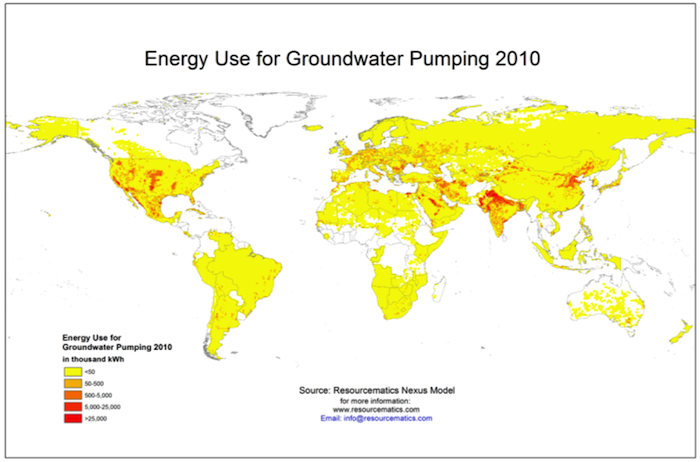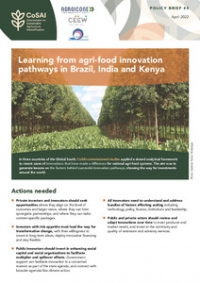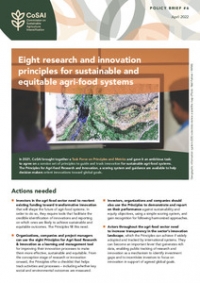Evaluating Energy Use for Groundwater Pumping
Across much of the world, climate change has already made its presence known. With surface water availability impacted by common climate change symptoms like shifting seasonal rains, changing glacial melt patterns, and intensified droughts and floods, many farmers have long ago turned to groundwater pumping to cope with supply shortages at the surface and meet increasing demand for agricultural produce.
As pumping has intensified in recent decades, however, groundwater levels have dropped precipitously in many countries, requiring deeper wells and ever-greater amounts of energy to bring water to the surface. Since groundwater provides farmers with a sort of insurance coverage to ensure their water security in periods of drought, seemingly no amount of energy is spared when it comes to pumping aquifers, especially those under arid and semi-arid regions.
So how much energy do we use to access this water source? The answer has remained something of a mystery — until now.

Understanding the water energy nexus
A new online tool, Resourcematics’ Water Energy Nexus Model, promises to shed some much-needed light on the energy footprint of groundwater extraction. The tool provides online users with a scalable and customizable map revealing the energy intensity (measured in kilowatt hours) of groundwater pumping across the world. It generates these estimates by drawing from a variety of sources for groundwater data, including satellite mapping, geographic information systems (GIS), on-the-ground data collection, and interviews with farmers and water researchers.
One of the tool’s main appeals lies in the details — the map can produce results for an area as small as 81 square kilometers at the global equator and for an area as small as 45-50 square kilometers in the middle latitudes. The tool’s accuracy is enhanced through its analysis of local hydro-geological conditions and its incorporation of available technical pumping data (such as pump size, depth, lift, velocity, and efficiency). The tool also provides users with data revealing the percentage of a nation’s overall energy usage consumed by groundwater extraction.
Fitting new data into the groundwater puzzle
The Water Energy Nexus Model could prove particularly useful when its mapping is combined or overlapped with online mapping generated by other recent breakthrough groundwater modeling technology, such as the groundwater depletion maps produced by the GRACE satellite mission. Businesses, researchers, and water policymakers are particularly well-positioned to benefit from such information.
But does the tool’s data have any relevance to smaller-scale water users, such as farmers, development practitioners, or community water managers? After all, it is unclear how well the Water Energy Nexus Model maps might translate onto the screen of a mobile device in countries where laptops are few and far between, and most small-scale water users who have their own pumps are already well aware they spend more money and fuel on pumping than they would probably like.
Resourcematics director Ankit Patel tells Thrive that since “groundwater is quite local,” even the tool’s high-resolution data may not prove detailed enough to provide water users with useful new information about energy usage on individual farms, especially smaller plots. But he believes the tool can certainly help farmers in understanding “how much groundwater is cumulatively being used in the neighborhood.”
IWMI’s Pennan Chinnasamy thinks these estimates could assist broader efforts to bring groundwater pumping under control in water-stressed areas. “Such information will be valuable for small-scale farmers and government agencies in estimating sustainable groundwater use rates, which might differ spatially and temporally due to varying climatic and geologic settings,” he tells Thrive.
Improving a community’s understanding of how much energy is expended on groundwater pumping can not only provide insights into how long local aquifer supplies may last, but also — depending upon the severity of the situation — build public support for water conservation in groundwater-scarce communities with the right institutional infrastructure.
In other cases, even if groundwater pumping continues at current rates (or further intensifies), the Water Energy Nexus Model’s data can encourage additional investment in green energy for groundwater pumping. Since most global groundwater extraction is still powered by fossil fuels, the tool provides users with estimates of solar energy generating potential on the surface overlying aquifers, providing a sense of how much surface area would be need to be set aside to install solar energy infrastructure for groundwater pumping.
Communities with significant annual sunlight, especially those across North Africa, the Middle East, and parts of India, would be particularly well-suited to greening their groundwater harvesting practices in this way. In fact, India — the world’s largest groundwater user by volume — is currently leading that charge, with farmers using solar energy to pump groundwater and then selling surplus energy back to the grid. This arrangement provides an incentive for farmers to use only the minimum amount of energy they need to pump water, since they can sell the rest to the grid for a profit.
Resisting complacency at a time of cheap oil prices
Green energy and public awareness alone cannot solve many countries’ groundwater problems. Low oil prices have further complicated matters by easing the financial burden many groundwater pumpers face, discouraging them from finding energy-efficient solutions for operating pumps. Many governments further facilitate energy-intensive aquifer depletion by offering fuel subsidies and leaving groundwater pumping virtually unregulated, making groundwater a more-or-less free resource with no built-in financial incentives for public or private conservation.
Given the scope of global ground water depletion, groundwater managers should take a more serious look at harnessing gravity — not to pump groundwater, but to return it to the earth. Managed aquifer recharge and underground water storage stand out as arguably the most energy-friendly solutions for improving groundwater security, and can be achieved in an environmentally sustainable fashion through basic rainwater harvesting and flood harvesting techniques. Over time, managed aquifer recharge would provide the additional benefit of lowering energy expenditures for groundwater pumping, since the water table would be accessible at lesser depths.
The severe groundwater depletion problem we face today is perhaps the biggest unintended consequence of the Green Revolution’s successes in how we have grown food over the past 50 years. The revolution’s far-reaching agricultural advances have enabled the world population to roughly triple since the mid-20th century — growth that has come at the expense of our finite groundwater supplies and other vital natural resources. Recognizing our energy-intensive groundwater usage is unsustainable will put us one step closer to identifying and implementing practices for easing the world’s groundwater crunch, and improving water security in the most at-risk communities.














